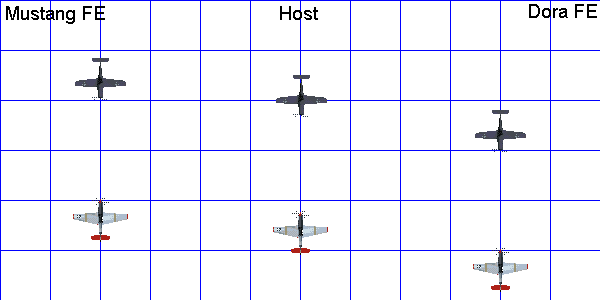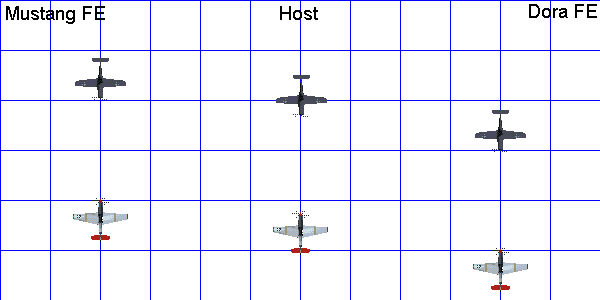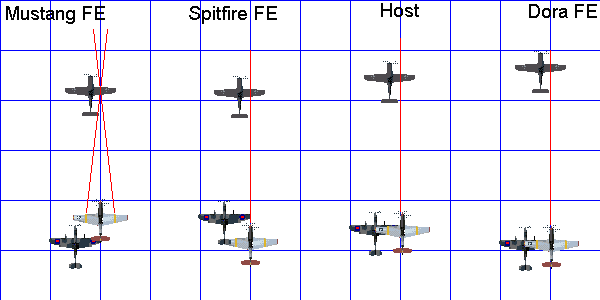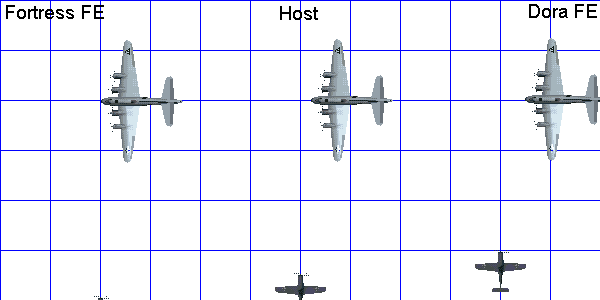Netlag and Collisions
Some players state that collisions should always occur between 2 planes, hurting both
pilots. While this is true in a real life, real time situation, it is not true
in the environment of online play. Here simple relativity dictates the physics
of collisions through netlag.
My knowledge of the subject comes from several sources and my own cognitive skills
(math and physics degree). One such source for achieving a deep understanding
of netlag is
Hoof's explanation.
What I am attempting to do here is simplify that and put into picture what is going
on.
To get us started, let's look at the most simplified situation. Here we have
a Mustang and Dora playing chicken. Neither one will dodge--both will die. In
this example, the Mustang has a ping time of 100ms and the Dora has a ping time
of 200ms. Each frame of the moving Gif represents passage of 100 ms. I am ignoring
processing time on the Host, but that can be incorporated into the ping time
and ignored. Notice that 2 FE's(front-end) view each other 300ms in the past (their total ping
times)

Some believe that a faster connection will come out OK. This is not the case.
This is because collisions occur on the FE and the time it takes to
transfer information between the FE's via the host is the same no matter which
way you travel. The only difference in the 2 FE's is where the collision takes
place. An outside witness to this collision would view it the same as the Host,
only delayed by the viewer's ping time. Notice that the 2 planes explode behind
each other on the Host. I have witnessed this several times while playing.
To complicate matters we could consider acceleration. I have to study this more,
but I believe that the plane with the least acceleration (not least speed) may
actually have a few more milliseconds to make an evasive maneuver, but probably not
enough to make a big difference
Now, some argue that both should die in a collision. But, as this next picture
shows, that is ill-thought. In this moving Gif, the settings are just as the one
above, but the Mustang makes an evasive maneuver, while the Dora continues on with
his game of chicken.

There is no reason that the Mustang pilot should be punished for a collision
he clearly avoids on his FE. The Mustang makes his move 300ms prior to the merge,
thus the Dora's FE never receives the data stating this and to the Dora, both
collide head-on. The Mustang checks his '6' and sees the Dora blow up behind him.
I show the next picture to demonstrate a couple of
things. This is a snap shot of everyone involved in a tail chase, all players
having the same ping time. On the Mustang's FE, he is firing a clear shot at the Dora.
However, the Spitfire sees the Mustang firing tracers over his shoulder on his
FE. Some pilots get upset at this not realizing that due to netlag, they may be
behind the guy firing over their shoulder on his FE. If the Spitfire was firing,
the Mustang would also see tracers coming over his shoulder.

Also note the distance between the chasers and the one being chased. The Mustang
sees the Dora at convergence and fires. Hits on the Dora are computed
on the Mustang's FE and thus the Dora's wing will soon be missing. However, the Dora
sees the Mustang further back and then wonders how he was shot down so easily.
The Dora pilot has nothing to complain about, he was a victim of netlag. He
should have made his defensive move when the Mustang was further out.
A straight rear collision should result in a death to both parties, but I believe
the game is programmed to only kill the rammer. In this situation, the Mustang
would collide first but by the time that information reaches the Dora, the Mustang
would be hitting its rudder. Once again though, acceleration may effect the outcome.
In most situations the chaser has more acceleration. In such a case, the Dora may
see the Mustang blow up well behind him in a rear collision.
As for purposely ramming planes, particularly buffs, the straight head-on
is the only way to accomplish this. This will also result in the rammer's death.
However, any slight deviation will more than likely result in only the rammer's
death (such as inbound slightly off angle). To demonstrate this to the extreme,
consider a Dora trying to ram a B17 from the side. In this moving Gif, both
planes have the same ping time, and the Dora is moving twice as fast as the Fortress.

In this case, 'Otto' scores an easy kill and is not even aware there was a collision.
The merge on the Fortress's FE was not even close.
It is important to note here that these graphics demonstrate lag on a 2 dimensional
surface. In the game we have to deal with 3 dimensions which just adds another
variable.

TROY'S WARBIRDS PAGE




